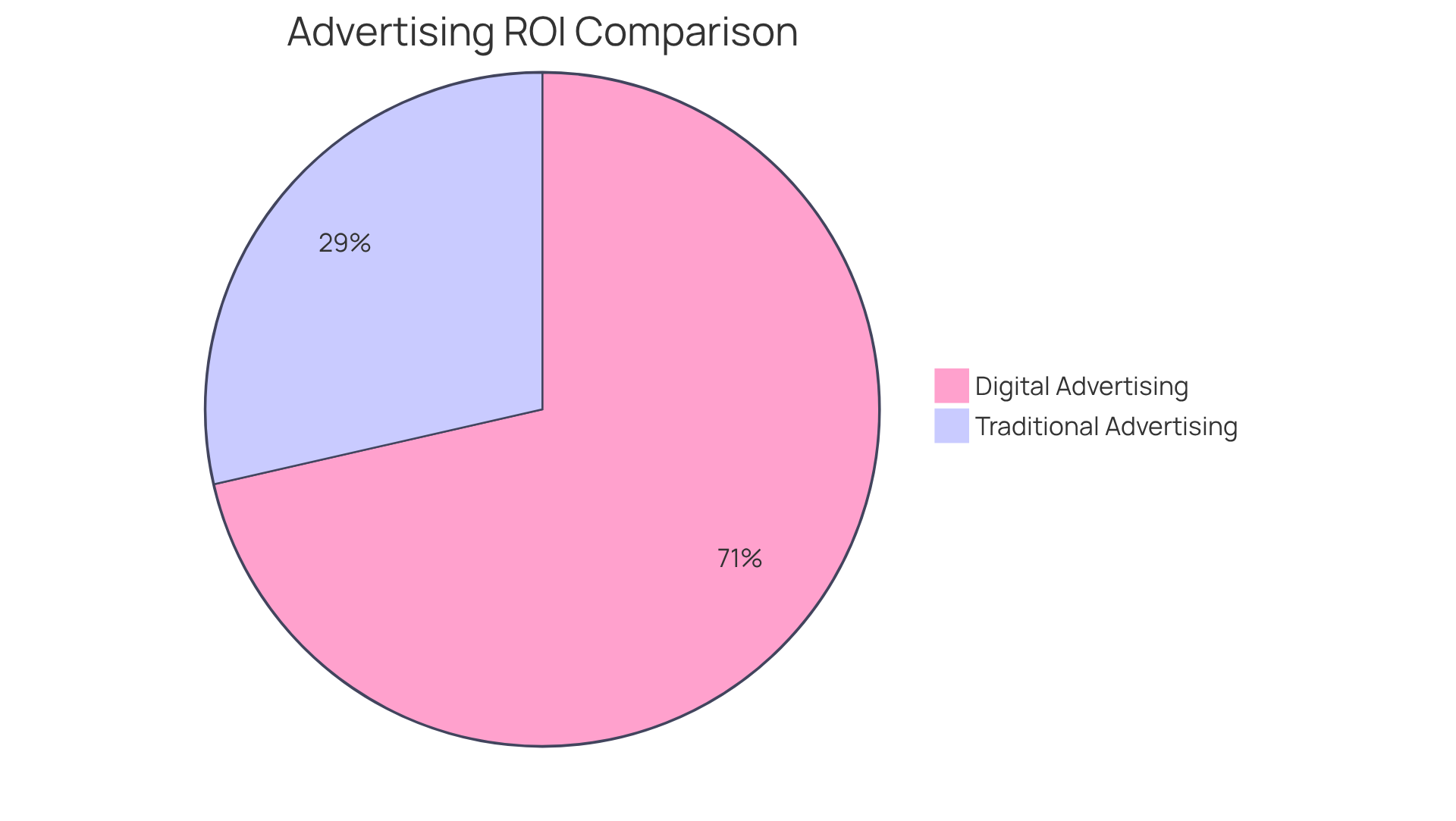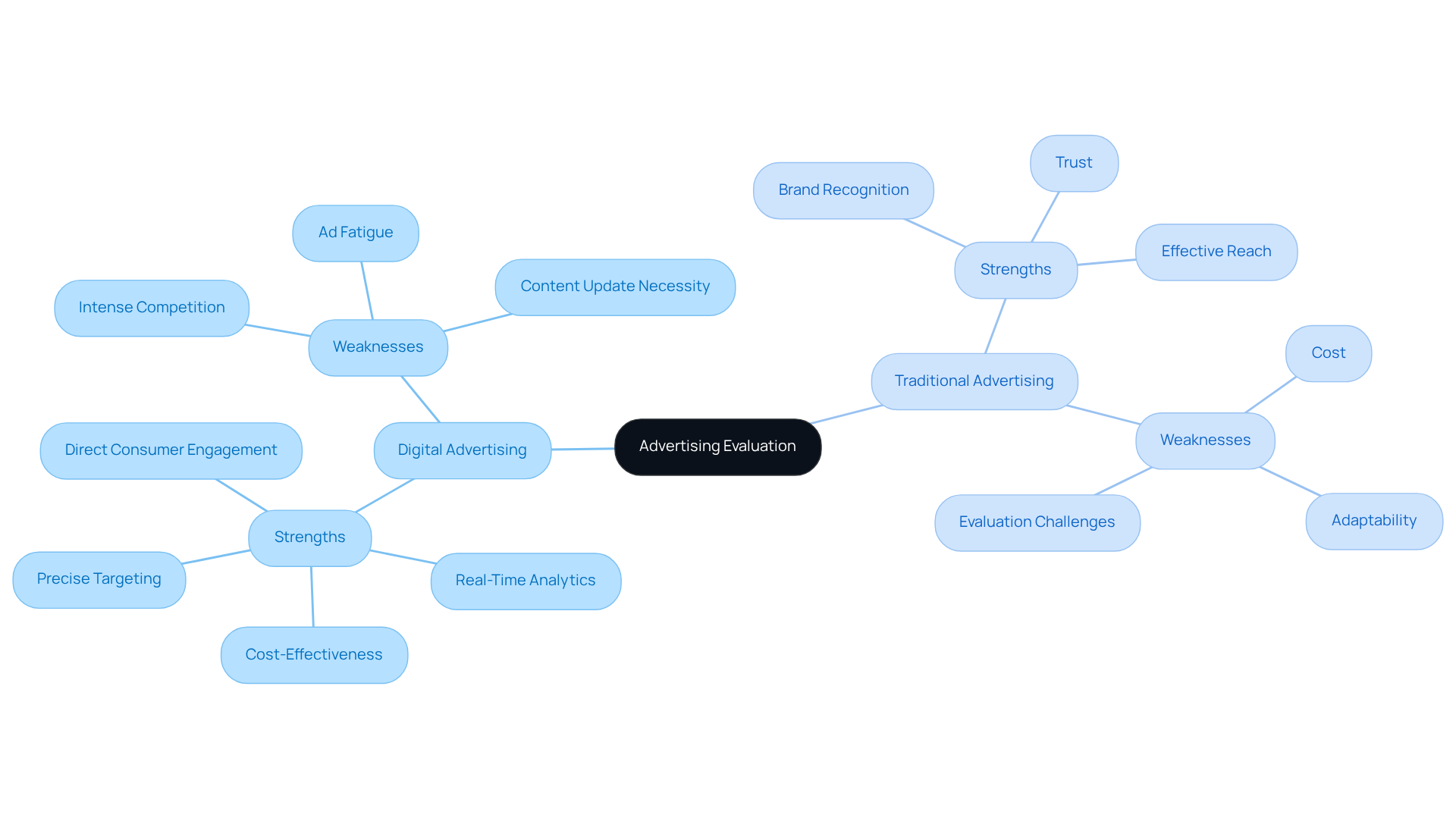
Introduction
In a rapidly evolving marketing landscape, the battle between digital ad companies and traditional advertising methods intensifies. Each method vies for attention in a crowded marketplace, making it crucial for marketers to understand their strengths and weaknesses.
- Digital advertising boasts unparalleled precision, real-time analytics, and cost-effectiveness, making it a favorite among brands eager to engage tech-savvy consumers.
- However, traditional advertising still commands respect for its ability to foster trust and reach broader demographics.
As marketers weigh these approaches, a pressing question emerges: which strategy truly reigns supreme in delivering measurable results and consumer engagement in 2025?
Defining Digital Advertising and Traditional Advertising
Digital promotion involves marketing strategies employed by digital ad companies that leverage online platforms - think social media, search engines, and websites - to engage consumers effectively. This method stands out for its ability to target specific demographics precisely, track engagement in real-time, and adapt campaigns based on performance metrics, which is essential for digital ad companies. In contrast, conventional promotion relies on offline channels like television, radio, print media, and billboards. While it aims for a broader audience reach, it often lacks the precision and immediacy that online methods provide. Conventional promotion typically utilizes established media channels to disseminate messages, whereas online marketing harnesses technology to foster interactive and tailored user experiences.
Looking ahead to 2025, the conventional marketing sector is projected to reach $200 billion, underscoring its enduring presence despite the rapid growth of online platforms, which are expected to soar to $800 billion globally. Experts note that while traditional methods can build brand trust and awareness, the flexibility and data-driven insights offered by digital ad companies are increasingly favored in today’s fast-paced market. For instance, a 2024 Adobe report revealed that 73% of online marketers value the adaptability of online campaigns, allowing them to respond swiftly to emerging trends and consumer behaviors. Moreover, attention data has become pivotal in budgeting discussions, as marketers recognize that real impact arises from moments when viewers are engaged and responsive to a message. This shift underscores the growing influence of online promotions on consumer decision-making, as brands increasingly prioritize interactive formats that facilitate prompt engagement and conversion.

Comparing ROI Metrics: Digital vs. Traditional Advertising
Digital promotion consistently outperforms traditional methods in terms of return on investment (ROI) metrics, primarily due to its lower costs and enhanced engagement rates. For example, online campaigns often achieve a return on ad spend (ROAS) of 5:1 or higher, which is considered a favorable marketing ROI-indicating $5 earned for every $1 invested. In contrast, traditional marketing typically struggles to exceed a 2:1 ratio. This disparity is evident in a case study where a retailer redirected 60% of their conventional marketing budget into targeted online channels, resulting in a tripled ROI and immediate performance insights that older methods could not provide.
Digital platforms deliver detailed analytics, allowing marketers to track conversions, customer acquisition costs, and engagement rates in real-time. Conversely, traditional advertising relies heavily on estimates and surveys, making it difficult to accurately measure true ROI. While online marketing can yield an average ROI of 5:1, conventional approaches often fall short, with many campaigns failing to deliver quantifiable results. Additionally, traditional marketing methods can be costly and challenging to track, leading to potential budget waste.
Furthermore, brands leveraging online strategies have reported remarkable successes. For instance, an e-commerce firm that invested $100,000 in PPC promotion generated $2.5 million in revenue, showcasing a ROAS of 2.50 and an ROI of 150%. This illustrates how online campaigns not only enhance visibility but also generate substantial financial returns.
As companies increasingly prioritize measurable results, the shift towards online promotion is becoming more pronounced. Many are recognizing its ability to optimize spending based on performance data. This trend underscores the growing preference for strategies employed by digital ad companies that deliver concrete outcomes over traditional marketing methods.

Evaluating Strengths and Weaknesses of Digital and Traditional Advertising
Digital ad companies present several compelling advantages of digital promotion, including precise targeting, real-time analytics, and cost-effectiveness. It empowers brands to engage directly with consumers through interactive content and social media platforms, fostering a dynamic two-way communication channel facilitated by digital ad companies. However, it also encounters challenges such as ad fatigue, intense competition with digital ad companies, and the necessity for constant content updates to sustain engagement.
Conversely, conventional advertising shines in brand recognition and trust, often perceived as more credible by certain demographics. It effectively reaches audiences who may be less engaged with online media, particularly older generations. Yet, traditional methods tend to be more expensive, less adaptable, and harder to evaluate in terms of effectiveness. This duality underscores the importance of integrating both strategies for a comprehensive marketing approach.
A 2024 HubSpot study revealed that digital ad companies utilizing online campaigns achieve an average ROI of $2.80 for every dollar invested, compared to the less clear $1.50 from conventional methods. As Itamar Haim notes, 'Online marketing allows you to adapt your strategies quickly,' emphasizing the flexibility that digital ad companies offer in a rapidly evolving landscape.
In 2025, consumer trust in traditional promotion remains robust, with 72% of consumers still favoring print ads over online ones, while only 41% trust online promotions. This indicates that while digital marketing is crucial, traditional methods still play a vital role in establishing credibility and brand loyalty. Furthermore, the decline in print news consumption, with only 10% of individuals accessing news through print, highlights the shifting landscape of consumer preferences.

Determining Suitability: When to Choose Digital or Traditional Advertising
Choosing the right marketing strategy is crucial for success. It hinges on understanding your target audience and the specific objectives of your campaign. Digital ad companies stand out for engaging younger, tech-savvy consumers who are immersed in online content. It provides the agility necessary for campaigns that demand quick adjustments and real-time performance feedback.
Conversely, traditional advertising remains a formidable tool for brands aiming to establish broad awareness, particularly among older demographics who may prefer established media formats. For example, a local business could effectively combine online advertisements for immediate interaction with traditional print ads to bolster its community presence.
Marketing strategists assert that a hybrid approach, integrating both digital ad companies and traditional methods, often yields the best results. This strategy leverages the unique strengths of each medium, maximizing reach and enhancing overall campaign effectiveness. It caters to diverse audience preferences, especially as we look ahead to 2025.
In conclusion, understanding the nuances of both digital and traditional marketing is essential. By adopting a hybrid strategy, brands can not only reach a wider audience but also engage them more effectively. What strategies are you considering to enhance your marketing efforts?

Conclusion
Digital advertising and traditional advertising each present unique strengths and challenges, making the choice between them a nuanced decision for marketers. The effectiveness of digital methods-characterized by precise targeting, real-time analytics, and superior ROI metrics-positions them as a compelling option in a rapidly evolving marketplace. Meanwhile, traditional advertising retains its relevance through brand trust and broader audience reach, particularly among demographics less engaged with digital platforms.
Key insights reveal that digital campaigns often lead to significantly higher returns on investment, boasting an average ROAS of 5:1 compared to the 2:1 typical of traditional methods. The ability to adapt swiftly to consumer behavior and market trends further enhances the appeal of digital strategies. However, the credibility and recognition that traditional advertising provides cannot be overlooked, especially for brands seeking to establish a strong community presence.
In light of these considerations, adopting a hybrid approach that leverages the strengths of both digital and traditional advertising is increasingly recognized as the most effective strategy. This comprehensive method not only maximizes audience reach but also fosters deeper engagement across diverse consumer segments. As marketers evaluate their options moving forward, embracing both realms can lead to innovative and effective campaigns that resonate with a wide array of audiences.
Frequently Asked Questions
What is digital advertising?
Digital advertising involves marketing strategies used by digital ad companies that leverage online platforms such as social media, search engines, and websites to effectively engage consumers.
How does digital advertising differ from traditional advertising?
Digital advertising targets specific demographics precisely, tracks engagement in real-time, and adapts campaigns based on performance metrics. In contrast, traditional advertising relies on offline channels like television, radio, print media, and billboards, aiming for a broader audience reach but lacking the precision and immediacy of online methods.
What are the projected market values for traditional and digital advertising by 2025?
The traditional marketing sector is projected to reach $200 billion, while online platforms are expected to soar to $800 billion globally.
What advantages do digital advertising methods offer?
Digital advertising offers flexibility, data-driven insights, and the ability to respond swiftly to emerging trends and consumer behaviors, which are increasingly favored in today's fast-paced market.
How important is attention data in digital advertising?
Attention data has become pivotal in budgeting discussions, as marketers recognize that real impact arises from moments when viewers are engaged and responsive to a message.
Why are brands prioritizing interactive formats in advertising?
Brands are prioritizing interactive formats because they facilitate prompt engagement and conversion, reflecting the growing influence of online promotions on consumer decision-making.





